Excerpts from Jim Conrad's
Naturalist Newsletter
Entry from field notes dated June 29, 2023, taken along one-lane gravel road in valley between Puerto del Zenthé and Chavarrías in mountainous area with a maze of roads too complex to say how to get there; in general it's in the mountains of east-central Querétaro state, municipality of Cadereyta de Montes, 12 straight-line kms due east of Vizarrón de Montes but much farther by twisting roads; juniper-scrub forest; limestone bedrock; elevation ~2860m (~9400 ft), Querétaro, MÉXICO, (N20.84122°, W99.60509°)
GUMWEED
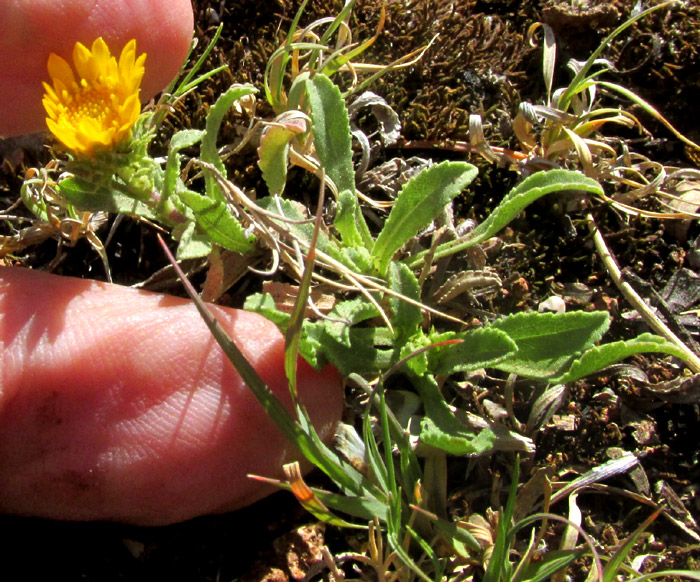
In a semi-open spot surrounded mostly by junipers and sometimes grazed by roaming cattle, the above small wildflower was opening its flowering head, closer seen below:

With its petal-like ray florets radiating from an "eye" populated with many, mostly unopened disc florets, it's a classic member of the most species-diverse of all plant families, the Composite/Aster/Sunflower Family, the Asteraceae. Around the eye's periphery, disc florets are just beginning to issue yellow, clumping grains of pollen. It's a young flowering head, maybe opening up today for the first time in its life.
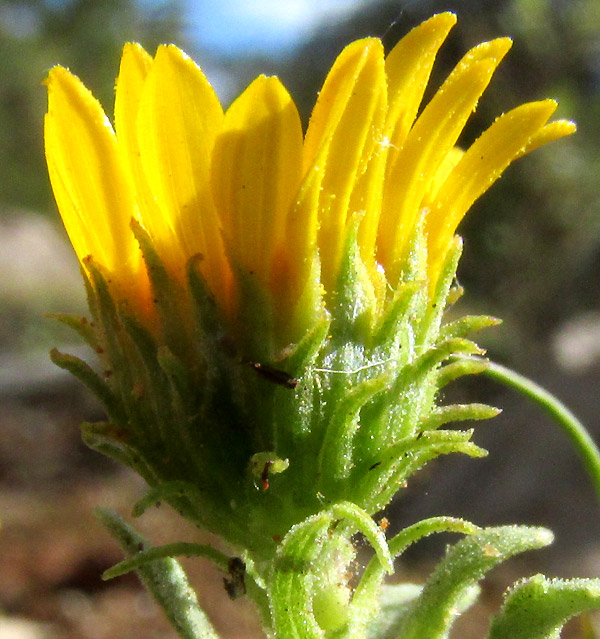
In Mexico, when confronted with an Aster Family species you've never seen and want to identify, prepare yourself for a challenge. José Luis Villaseñor's 2018 study "Diversidad y distribución de la familia Asteraceae en México" registers in that family -- just for here in Mexico -- 417 genera embracing 3,113 species. And an astonishing number of those 3,113 species produce yellow ray and disc florets.
Above, note how green, scale-like bracts form a deep bowl-shaped involucre below the bouquet of florets. The bracts are unusually numerous, slender, of similar lengths, and their tips tend to curve outward from the involucre. The nature of the hairs covering the above green parts is best seen in the picture's lower, right corner. It looks as if we have a dense covering of very small, short hairs tipped with what probably are glands.
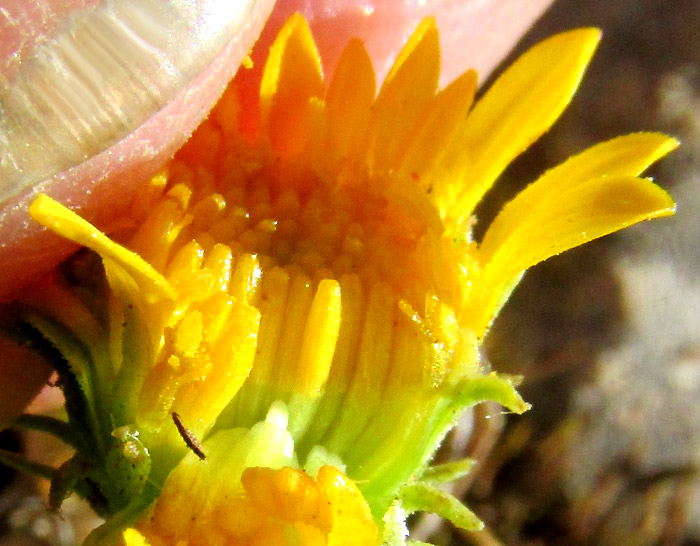
For identification purposes when working with the Aster Family, often you need to break open a flower head, or capitulum. Above we see that no scale-like paleae separate disc florets from one another. Below the disc florets' cylindrical, yellow corollas, the pale green, rice-grain-shaped items are the ovaries, the future one-seeded, cypsela-type fruits. Typically, but not always, pappi appear atop each ovary. The pappus, if present, may take various shapes and forms, from low crowns to sharp spines or white, hairlike bristles, which can be filament-like or feathery. It's hard to say what's seen above; maybe there's some small, weak bristles, but nothing obvious. Later I'd read that two small ones are present, but fall off.
But, in the above picture, what's that white blob at the bases of certain disc florets? It looks like white latex of the kind bled by dandelions and lettuce, which are Aster Family members. Seeing that, I got a hunch that might provide a shortcut in the identification effort. I'd seen Aster-Family species with yellow ray and disc florets, and which readily issued white latex in their flowering heads, and they had similarly numerous, narrow, out-curving involucral bracts, too. On dry mountain slopes in Oregon there was Gumweed, genus Grindelia, in whose flowering heads sometimes disc flowers would be submerged beneath a thick pool of white latex, the "gum" in gumweed. But, before checking to see if our plant is another species of gumweed, here's a look at the leaves' sawtoothed margins:

Our plant's features did match those of gumweeds, but the genus Grindelia embraces over 80 species, all native American and with a fair number in Mexico. No general treatment of the gumweeds in our area is available. However, in 2012 Adriana Bartoli and Roberto Tortosa published the "Revision of the North American Species of Grindelia (Asteraceae)," which treats at least some Mexico species. In that work, our plants key out to -- and seem to be -- GRINDELIA INULOIDES. The plant has no English name just for itself, but "gumweed"can be used for all Grindelia species.
Grindelia inuloides is endemic to Mexico's uplands from the north-central region south to Oaxaca, sometimes in disturbed areas. Bartoli and Tortosa recognize three varieties of the species. If we agree that in our picture of the involucre the green parts are covered with short, gland-tipped hairs and that the leaves are less than 1.5 wide (5/8 inch), which seems the case to me, we have the variety glandulosa. Supporting that choice is that this is the only variety found as high in elevation as our plants -- ~2860m (~9400ft).
The most noteworthy feature of the gumweeds surely is the copious white latex they produce when injured, and sometimes, in my experience, when no injury is apparent. I've seen small insects mired in gumweed latex so possibly the white sap keeps small creatures from feeding on it. Maybe if an insect chews into it, immediately its mouthparts get all gummed up.
Also, Google Patents posts online Patent #US3151092A, relating to a "freeze resistant latex prepared from a grindelia extract." The inventor claims that if you mash entire Grindelia squarrosa plants -- the same species we met in Oregon -- and leach the latex from the resulting slurry, the latex can be incorporated into latex paint to prevent future freeze damage. Maybe the latex does something similar for our plants.
In Mexico, I can't imagine how many traditional medicinal plants are called árnica, and this is one of them. Most árnicas are yellow-flowered members of the Aster Family, such as the tree-like Giant Mexican Sunflower, but then there are árnicas like the white-rayed one English speakers call Lazydaisy. In the 2006 work by David Martínez-Moreno and others entitled "Plantas Medicinales de Cuatro Mercados del Estado de Puebla, México," our plant was found being sold as a medicinal herb in traditional markets in Puebla, Mexico, under the name of árnica. Soak the plants in water, then wash wounds with it, or soak a body part hurting from being hit.
Entry from field notes dated June 30, 2023, along narrow, very steep, cobblestone road descending on the south side of El Doctor toward the Cueva del Tecolote, passing among cultivated fields and pastures; in the mountains of east-central Querétaro state, municipality of Cadereyta de Montes, 12 straight-line kms due east of Vizarrón de Montes but much farther by twisting roads; elevation ~2740m (~8900 ft), Querétaro, MÉXICO, (N20.84704°, W99.58573°)
GUMWEED MORE ADVANCED
The day after the above plant was met, lower in elevation and in a moister valley I find more mature gumweeds. The blossoms of these are more open:
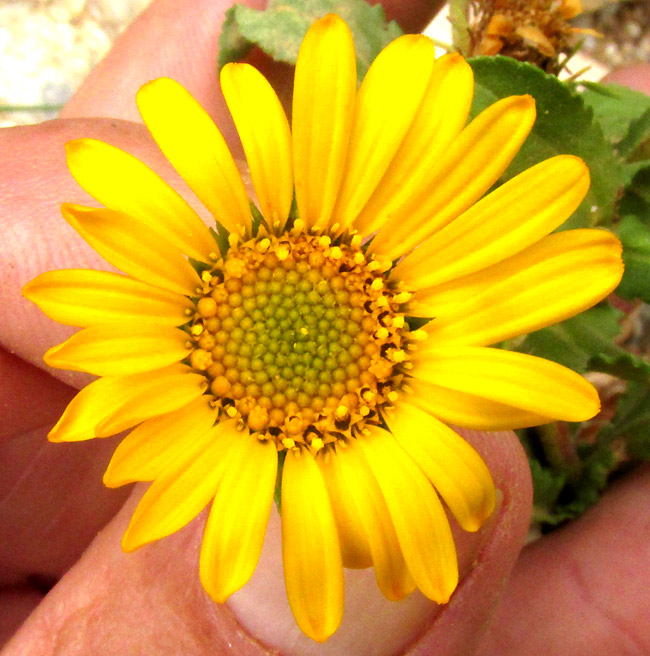
This time the pappuses' one or two white bristles are clearly seen atop each cypsela:
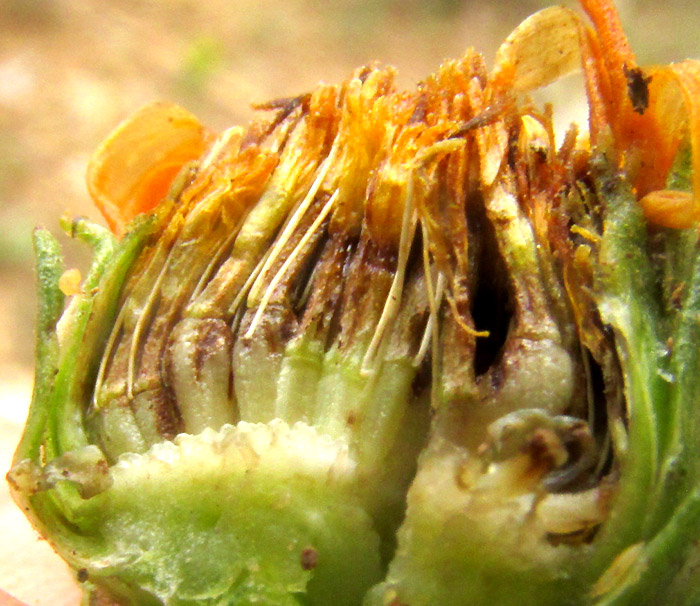
Also this times I got a better view of the leaf bases:
